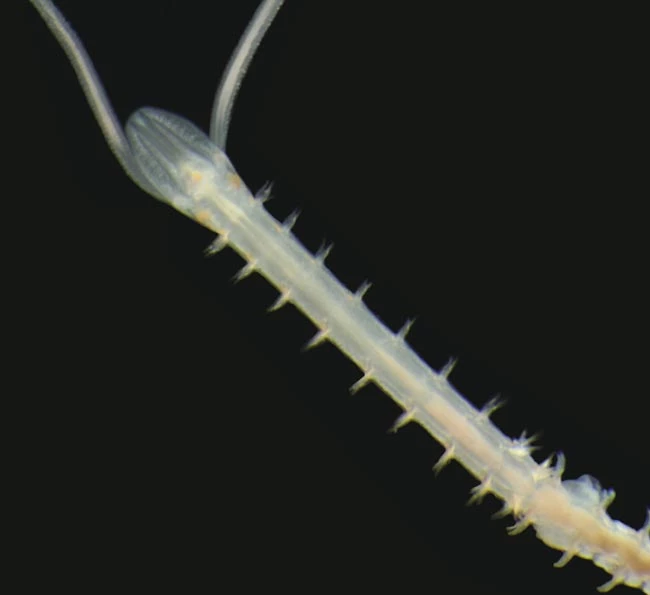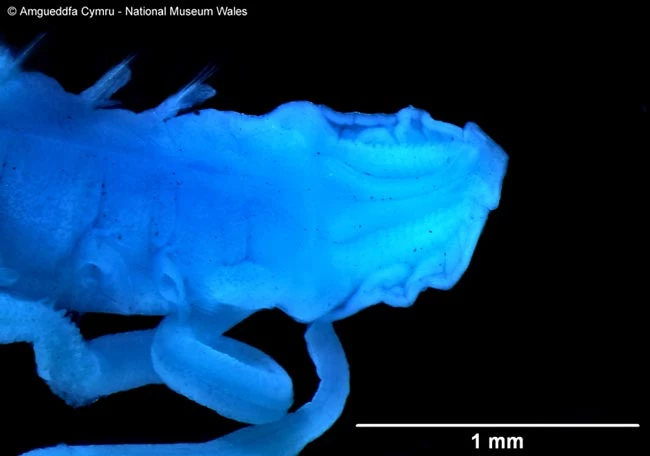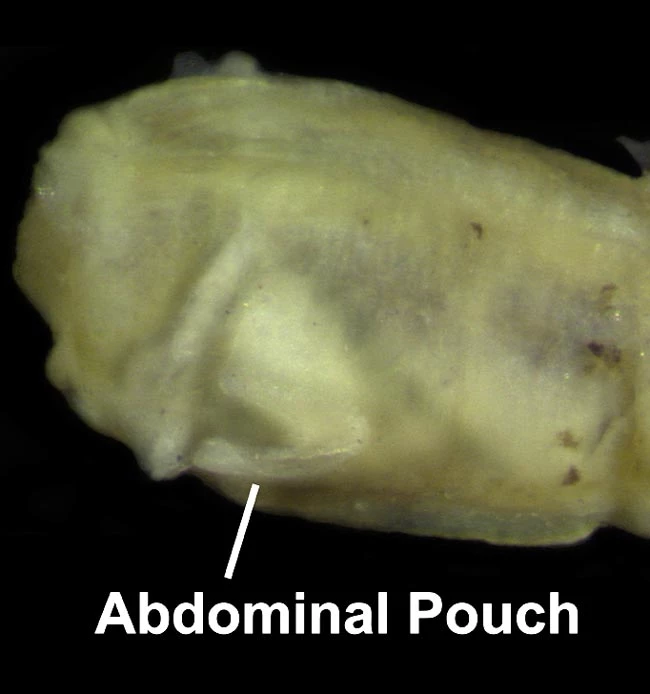Species new to science: Shovelhead Worms from around the world
A British species of Shovelhead worm (Magelona johnstoni). Image: Andy Mackie.
A Portuguese species of Shovelhead worm (Magelona lusitanica)
Head end of Magelona montera from the Red Sea, stained with methyl green. Image: James Turner
from the Gulf of Aden
Head end of Magelona sinbadi from the Persian Gulf, stained with methyl green. Image: James Turner
An example of a magelonid pouch
Marine bristle-worms (Polychaetes) are related to earthworms and leeches - well known examples are lugworms and ragworms used by sea fisherman as bait. The Magelonidae is a small family of polychaetes that have a unique flattened head, used for digging, giving them the common name, the shovelhead worms. There are over 70 species of shovelhead worms, 11 of which were first described by marine biologists from Amgueddfa Cymru.
Polychaetes are found in nearly every marine habitat and often make up a large proportion of the animals living in and on the seabed. There may be 9000 species worldwide, although estimates vary widely and new species are being discovered constantly (even in British waters).
Polychaetes can vary hugely in their form and size, how mobile they are, and how they obtain their food.
What are Shovelhead Worms (Polychaeta: Magelonidae)?
The Magelonidae is a small family of polychaetes, found all over the world. They burrow in muds and sands, and are generally found at water depths of less than 100 m. They are slender, beautiful worms, usually less than 10 cm long. They have a unique flattened head, used for digging in sediments, giving the group its common name, the shovelhead worms. The have two long feeding tentacles (palps) that are adorned with small 'bumps' (papillae). Over 70 species are known worldwide, 11 of which were first described by marine biologists from Amgueddfa Cymru, including one British species, Magelona johnstoni Fiege, Licher & Mackie, (2000).
Marine biologists at Amgueddfa Cymru have studied the shovelhead worms in the seas surrounding the Arabian Peninsula and confirmed the presence there of Magelona cornuta, Magelona obockensis, Magelona pulchella, Magelona crenulifrons and an undescribed species from the Red Sea (Mortimer, 2010). This research led to collaboration with scientists from the Spanish Centre d'Estudis Avançats de Blanes (CEAB) who made Magelona specimens available from over 100 locations in the same region.
A worm with horns
The undescribed species highlighted in 2010, was first noticed in the collections of the Muséum National d'Histoire Naturelle in Paris. It is a particularly interesting species as it has uniquely shaped horns on its head, giving it the appearance of wearing a bullfighter's hat! It has now been named Magelona montera, after the Spanish word for a matador's hat (Mortimer et al., 2012).
A further six species of Magelona have now been identified from seas surrounding the Arabian Peninsula, including another new species from Iran named after the fictional sailor, Sinbad (M. sinbadi, M. cf. agoensis, M. conversa, M. cf. falcifera, M. symmetrica, and M. cf. cincta). This raises the total number of species known from the Red Sea/Gulf region to eleven, three of which were originally described from the Seychelles by Museum staff (Mortimer & Mackie, 2003; 2006).
The partnership between Amgueddfa Cymru and CEAB has proven to be successful and also led to a review of the shovelhead worms from Portugal, including the description of a new species, Magelona lusitanica. This work was published in the proceedings of the 10th International Polychaete Conference, held in Italy, June 2010 (Mortimer, Gil & Fiege, 2011). In 2013, Museum staff worked with scientists from the East China Sea Fisheries Research Institute, Shanghai to describe a new species from the Yellow Sea, China (Zhou & Mortimer, 2013).
Amgueddfa Cymru taxonomists have now studied 30% of all known Magelona species. However, it doesn't stop there. Work is now starting on British species as part of the museum's review of the British Polychaete Fauna. We will also investigate the distinctive abdominal pouches present in some magelonid species, whose function remains a mystery.
References:
Fiege, D., Licher, F. & Mackie, A.S.Y. 2000. A partial review of the European Magelonidae (Annelida: Polychaeta): Magelona mirabilis redefined and M. johnstoni sp. nov. distinguished. Journal of the Marine Biological Association of the United Kingdom, 80, 215-234.
Mortimer, K. 2010. Magelonidae (Polychaeta) from the Arabian Peninsula: a review of known species, with notes on Magelona tinae from Thailand. Zootaxa, 2628, 1-26.
Mortimer, K., Cassà, S., Martin, D. & Gil, J. 2012. New records and new species of Magelonidae (Polychaeta) from the Arabian Peninsula, with a re-description of Magelona pacifica and a discussion on the magelonid buccal region. Zootaxa, 3331, 1-43.
Mortimer, K., Gil, J. & Fiege, D. 2011. Portuguese Magelona (Annelida: Magelonidae) with a description of a new species, a re-description of Magelona wilsoni Glémarec, 1966 and a key to adult Magelonidae from European waters. Italian Journal of Zoology, 78(S1), 124-139.
Mortimer, K. & Mackie, A.S.Y. 2003. The Magelonidae (Annelida: Polychaeta) from the Seychelles, with the description of three new species. In: Sigvaldadóttir, E., Mackie, A.S.Y., Helgason, G.V., Reish, D.J., Svavarsson, J., Steingrímsson, S.A. & Gudmundsson, G. (eds). Advances in polychaete research. Hydrobiologia, 496(1-3), 163-173.
Mortimer, K. & Mackie, A.S.Y. 2006. The Magelonidae (Annelida: Polychaeta) from the Seychelles. 2. Description of four additional species, three new to science. In: Sardá, R,. San Martín, G., López, E., Martin, D. & George, D. (eds). Scientific advances in polychaete research. Scientia Marina, 70(S3), 125-137.
Zhou, J. & Mortimer, K. 2013. A new species of Magelona (Polychaeta: Magelonidae) from Chinese coastal waters . Journal of the Marine Biological Association, U.K, 93(6):1503-1510.





